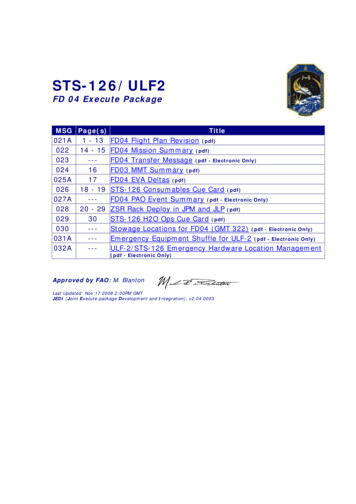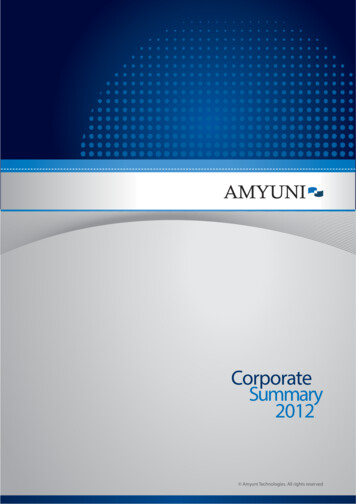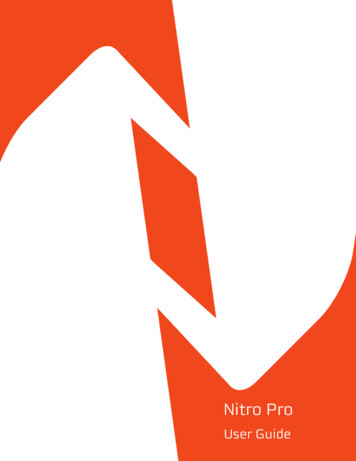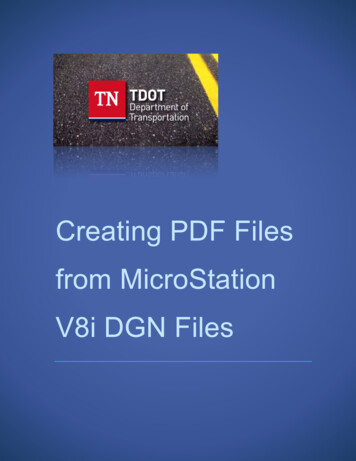
Transcription
IntroductionThis PDF presentation is designed to highlight the features and benefits of Plate HeatExchangers, both “bare” and “packaged” as opposed to other methods of heat transfer.This guide covers - When & why to use Plate Heat Exchangers (PHE’s)- Benefits that many heating engineers often overlook- How PHE's work- How to improve performance- How to reduce specification with pre designed packages- What mediums can be used- How to reduce on site assembly time for installers- Design/installation Diagrams- Building selection guideand much moreUltimately this guide serves to make the overall design process easier for consultants, and theinstallation a lot quicker and easier for contractors.If you need any help or further assistance with anything in this guide the Stokvis team wouldlove to hear from you. You can call us on 020 8783 3050 or visit stokvisboilers.com2
Plate Heat Exchanger Applications3
Plate Heat Exchangers (PHE)4
Typical ApplicationsØ Acting as a system break between Old and New heating systemsØ As a separation between systems due to pressure limitationsØ To convert MTHW to LTHWØ Act as an integration with Renewables (Biomass, Ground Source)ØDifferent mediums - Steam to LTHW or DHWS5
General Mechanical FeaturesØ Heat exchangers can accommodate a wide range oftemperatures and pressures for example:Ø Working Pressures up to 25 barØ System Operating Temperatures up to 150oCØ Port or Connection sizes available up to 300mmØPlates Pack materials available in high grade SS orTitanium.Ø Gasket materials are available in NBR, EPDM, VITONØ Fluids:- Can be used for Liquids and Steam6
Why Use Plate Heat Exchangers?Ø Small physical size:- Due to extremelylarge surface area for heat exchange givingeasy plant room access and locationØ Less fouling and scaling:- Due to highturbulence and smooth surfaces creates a selfcleaning action.Ø Easy to maintain:- By removing the frontchassis the plate pack is accessible.Ø No Cross Contamination - Double gasketsaround the ports with an opening toatmosphere to prevent cross contamination,with a visible leak.Ø Improved heat transfer –Thinner platematerial with the high turbulent flow 0.4 to0.6mm typicallyØ Easy to adjust or increase output:By addition of stainless steel plates.7
Additional Plate Heat Exchanger BenefitsØ No stored water to harbour bacteriaØ Fast heat up – almost instant – from coldØ Low water content, less water to treatØ Low water content, smaller expansion vesselsØ High pressure rating for sealed systemsØ Can be expanded to increase performanceØ High temperature drop on primary, small flow rates,smaller pipes, lower power pumpsØ They are a certified product with almost universalacceptance across the world, complying with the pressureequipment directive8
How do they work? – Single Pass9
How do they work?ØDouble Gasket Around Ports:This ensures NO crosscontamination is possible. A smallopening to atmosphere provides anearly warning of any gasket issuesin this area.ØChevron Design:- Alternateplate arrangement creates theturbulent flow and high heattransfer.ØDouble Gasket Arrangement:Alternates left to right ensuringprimary & secondary fluidsalternate across the pack.10
How can we change the performance?ØIncreasing the Performance:By increasing the flow rate throughthe PHE or by the simple additionof stainless steel plates to the platepack will provide an increase induty very quickly and at relativelylow cost. This is not possible with aCalorifier or Water heater.ØHigh Theta Plates:- Provide ahigher heat transfer and turbulent“self cleaning” effect, but have ahigher pressure dropØLow Theta Plates:- Provide alower heat transfer BUT do have alower pressure drop.11
What else is required to design a complete heatexchanger system?ØFor simple “system separation”/or “pressure break”you may only need a PHE with pumps on both theprimary & secondary circuits.This would be the case if the secondary temperaturedoes not need to be controlled at a different temperatureto the primary circuit. ie:- similar temperatures requiredon both sides of the PHE subject to the “Laws of HeatTransfer”.If different temperatures are required between side 1 andside 2 then you will need some form of temperaturecontrols and sensors which would probably act on a 2, 3or 4-Port control valve.Also safety devices to suit the system which could be anF&E Tank (open system) or Sealed system.(pressurisation set).12
For DHWS from LTHW we put together a package whichincludes.Ø A Packaged Plate Heat Exchanger with the following:Ø 10 bar primary, 6 bar secondary heat exchangerØ Max primary temperature 110oCØ Plate material 316, WRAS Approved EPDM gasketSØ Bespoke electronic PID temperature controllerto control modulating valve, pumps and provide faultindicationØ Primary and Secondary Pump(s)Ø Motorised control valve 2,3 or 4 port c/w fast actingactuatorØ Fast reading temperature sensorØ Non return valve for HWS returnØ Primary and secondary drain valve13
The package design process involves theselection of the pumpØ We select the correctly sizedstate of the art GrundfosMagna3 pump in accordancewith EuP Legislationintroduced in January 2013.Ø This transports primarywater from the heat sourcearound the heat exchanger andprovides the correct requiredflow rate through the PHE andover comes the PHE pressuredrop.14
Then the motorised valveØ We also size and select thecorrect size of valve and speedof actuation to regulate thevolume of primary water whichis allowed into the unit andthus control the secondarytemperature. The selectedvalve provides 0-100% fullmodulation.15
For the secondary side of a DHWS installation there aretwo possible configurationsØDHWS secondaryrecirculation:- An optionalsecondary DHWS recirculationpump can be included to providecirculation around thebuilding/system.ØBuffer Vessel:- An option toinclude a suitably sized “transferpump” is available when the PHEis being installed in conjunctionwith a buffer vessel.16
The finished itemØ The result would look likeour “E3Ci Series” Plate heatexchanger unit pictured herecomplete with ECONOTROL2100 PID temperaturecontroller, primary pump and 3port control valve17
Other things to considerØ You may also need springclosing 2-Port valve andmechanical reset high limitthermostats to comply with G3Building Regulations.18
G3 Regulation19
Why have another valve (G3)Ø On unvented systems, where the heat source is capable ofraising the temperature over 95 C, a manual reset high limitthermostat set to 90 C can be provided to interrupt the supplyof energy to the primary side of the heat exchanger.ØWhere a flow can persist, even when the high limit thermostathas switched off the primary pump, an additional spring returnprimary shut off valve, operated by the same manual reset highlimit thermostat set to 90 C, could be provided. This valve willalso interrupt the supply of energy if the electrical powersupply is interrupted.20
Insulation jacketsØ We supply easilyremovable insulationjackets to reduce heatloss but still allow easyservicing of the heatexchanger21
Advantages of Packaged PHE’SØ Reduced design requirements, matched set of components:pump, valve, actuator and controls are included as standard.Ø Reduced on site assembly time for the M&E installerØ Guarantees fast response to changes in the DHWS demandØ Accurate and close temperature controlØ Easy to use purpose built integrated controlsØ Mixing valve giving low temperature heat exchange at partload – reducing scale build upØ Full turbulent flow has a self cleaning affect on the platesreducing fouling and scalingØ Low water content less than 15 litres. No T&P required byG3 regulations.Ø Proven design.22
Advantages for hot water productionØ Units should be WRAS approvedØ No stored water, no static water, no stratificationØ Virtually eliminating risk of legionellosisØ Reduced total system volume:Ø Reduced size expansion vessel requiredØ Less chemicals needed to periodically treat the systemØ Reduced heat losses due to small size and small hold upvolume.23
Typical installation with a boiler24
Typical installation with a thermal store25
What about steamØ The principle is similarwithout the primary pumpØ Single or twin steamvalves dependent upon levelof safetyØ Safety shut off valvecomplete with high limitthermostat available.26
Why have another valve?Ø Other additional equipment required isfor high limit protection of the secondarycircuit to prevent the temperatureexceeding 95 CØ This should be a manual resetmechanical type of system, which will cutoff the steam supply in the event of a hightemperature scenario, caused by a failureof the control system or a loss of powerØ This can be included by selection of oneof the control valve options, or acompletely independent system could beused27
Steam processing and condense removalneeds to be allowed for28
A complete system with all steamAnd condense equipment shown29
Considerations for PHE’S for DHWS serviceØ High secondary pressure drop – not normallyan issue with boosted or mains pressure coldwater supplies.Ø Larger kW input required in comparison withstorage calorifiers – not normally an issue withhot water priority pipe-work arrangement.Ø Secondary pumped circulation must bemaintained around the building as an HWS return,locally if trace heated or around a buffer vessel30
Semi-Instantaneous DHWS Production withthe introduction of a Buffer VesselØ If storage is added it does not introduce the sameproblems as associated with calorifiers: slow heat up,stratification and cold spotsØ The volume of water can be heated up very quicklyØ The system does not rely on stratification, it uses acontinuous high flow pump to draw cold water from thetank through the heat exchanger and back to the tank,heating the water from cold to hot in a single passØ The secondary pressure drop is reduced to that of thevessel only31
Installation with a vessel32
Examples of ECONOPLATES with Buffer Vessels33
Mains ConnectionØ Pressure reducingvalve.Ø Double check valveØ Safety valveØ Expansion vessel34
Selection guide35
Heat Interface UnitsØ On a smaller scale we have H.I.U’s for individualdwellingsØ 3 basic formats are available:DIRECT HEATING & INDIRECT HOT WATER WITH 1 HEATEXCHANGER – temperature controlled production of DHWSfrom LTHWINDIRECT HEATING & INDIRECT HOT WATER WITH2 HEAT EXCHANGERS – system separation with temperaturecontrol and LTHW to DHWSINDIRECT HEAT ONLY WITH 1 HEAT EXCHANGER FORPROPERTIES WITH A DHW CYLINDER – system separationwith temperature control36
Direct heating and Indirect hot water –ECONOPLATE H137
Indirect heating and Indirect hot waterECONOPLATE H238
Indirect Heat only – H139
PHE PACKAGED UNITS40
Stokvis Industrial Boilers (International) LtdUnit 34 Central Park Estate34 Central AvenueWest MoleseySurreyKT8 2QZPhone: 020 8783 3050Fax: 020 8783 com/41
This PDF presentation is designed to highlight the features and benefits of Plate Heat Exchangers, both “bare” and “packaged” as opposed to other methods of heat transfer. This guide covers -When & why to use Plate Heat Exchangers (PHE’s)-Benefits that many heating engineers often overlook-H










